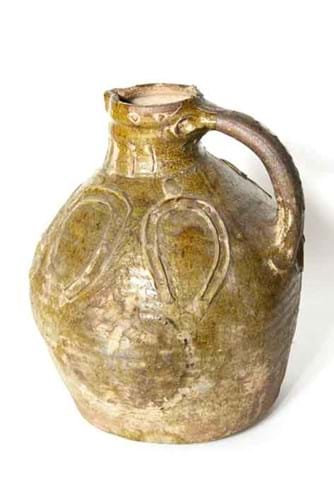
What they had found was the site of the medieval Burley Hill Pottery.
The finds were brought to the notice of the local antiquarian Llewellyn Jewitt whose excavations on Burley Hill found that two circular barrow-like mounds at opposite ends of the field were the discarded remains from a 13th century potter's kiln.
Large quantities of a distinctive brown lead-glazed earthenware characteristic of the late Norman period - predominantly fragments of small jugs, shallow dishes and porringers (or pippens as they were known locally) - were recovered on the instruction of the landowner Alfred Curzon, the 4th Baron Scarsdale (1831-1916).
However, the principal discovery among the Burley Duffield pots was a large, and wholly intact, 13th century ale or cider 'harvest' jug standing some 16in (41cm) high and applied with heraldic decoration in slip.
The device of three horseshoes and buckles is the badge of the Ferrers family, earls of Derby and Nottingham and the largest landowners in Derbyshire for much of the last millennium. Henry De Ferrers, a Norman soldier rewarded with land after victory at Hastings, had first built fortifications at Duffield in or around 1066, and it was logical to conclude that this jug had been made c.1220-50 for use by his descendants at the castle.
The pitcher appears to owe its preservation to a fire crack on one side near the bottom for which defect it was probably thrown aside by the potter. In the course of time it was buried. At the time of discovery, it was described as "one of the most important and interesting early medieval relics of the potters' art".
The jug remained in the collection at Kedleston Hall (although not recently on display) until current occupant, the Right Honourable Richard Curzon, chose to consign it for sale with Hansons of Etwall, Derbyshire on September 28.
Historical importance does not always translate into great financial worth for medieval vernacular pottery, but Charles Hanson's confident valuation of £30,000-50,000 was rewarded when it sold on the low estimate (plus 17.5% buyer's premium) to a private buyer.
A lot of money, but a lot of history too. "It really is a magical item," said Mr Hanson. "When I initially assessed the jug I was informed the pet dog had on a couple of occasions come close to wagging its tail a little too close and knocking it over."




